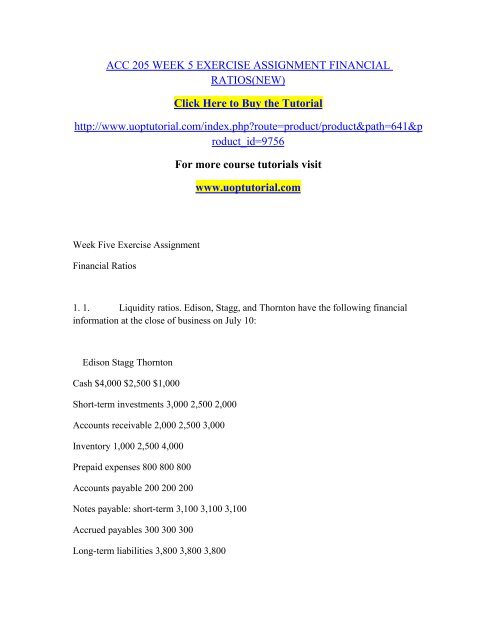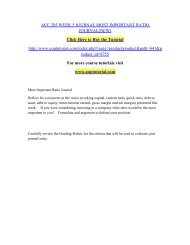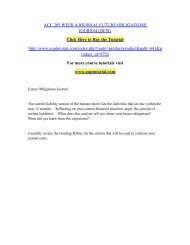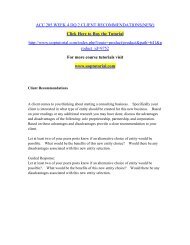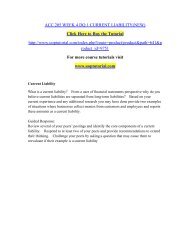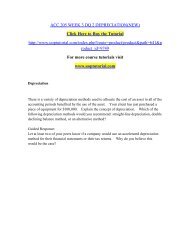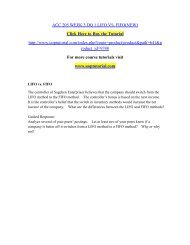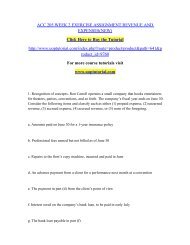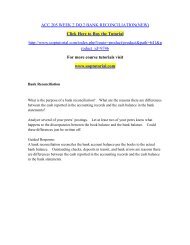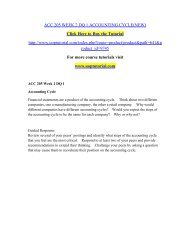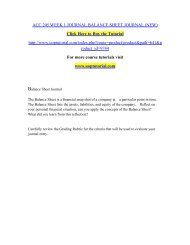ACC 205 WEEK 5 EXERCISE ASSIGNMENT FINANCIAL RATIOS(NEW)/Uoptutorial
You also want an ePaper? Increase the reach of your titles
YUMPU automatically turns print PDFs into web optimized ePapers that Google loves.
<strong>ACC</strong> <strong>205</strong> <strong>WEEK</strong> 5 <strong>EXERCISE</strong> <strong>ASSIGNMENT</strong> <strong>FINANCIAL</strong><br />
<strong>RATIOS</strong>(<strong>NEW</strong>)<br />
Click Here to Buy the Tutorial<br />
http://www.uoptutorial.com/index.php?route=product/product&path=641&p<br />
roduct_id=9756<br />
For more course tutorials visit<br />
www.uoptutorial.com<br />
Week Five Exercise Assignment<br />
Financial Ratios<br />
1. 1. Liquidity ratios. Edison, Stagg, and Thornton have the following financial<br />
information at the close of business on July 10:<br />
Edison Stagg Thornton<br />
Cash $4,000 $2,500 $1,000<br />
Short-term investments 3,000 2,500 2,000<br />
Accounts receivable 2,000 2,500 3,000<br />
Inventory 1,000 2,500 4,000<br />
Prepaid expenses 800 800 800<br />
Accounts payable 200 200 200<br />
Notes payable: short-term 3,100 3,100 3,100<br />
Accrued payables 300 300 300<br />
Long-term liabilities 3,800 3,800 3,800
1. Compute the current and quick ratios for each of the three companies. (Round<br />
calculations to two decimal places.) Which firm is the most liquid? Why?<br />
2. Suppose Thornton is using FIFO for inventory valuation and Edison is using LIFO.<br />
Comment on the comparability of information between these two companies.<br />
3. If all short-term notes payable are due on July 11 at 8 a.m., comment on each<br />
company's ability to settle its obligation in a timely manner.<br />
1. 2. Computation and evaluation of activity ratios. The following data relate to<br />
Alaska Products, Inc:<br />
19X5 19X4<br />
Net credit sales $832,000 $760,000<br />
Cost of goods sold 440,000 350,000<br />
Cash, Dec. 31 125,000 110,000<br />
Accounts receivable, Dec. 31 180,000 140,000<br />
Inventory, Dec. 31 70,000 50,000<br />
Accounts payable, Dec. 31 115,000 108,000<br />
The company is planning to borrow $300,000 via a 90-day bank loan to cover short-term<br />
operating needs.<br />
1. Compute the accounts receivable and inventory turnover ratios for 19X5. Alaska<br />
rounds all calculations to two decimal places.<br />
2. Study the ratios from part (a) and comment on the company's ability to repay a bank<br />
loan in 90 days.
3. Suppose that Alaska's major line of business involves the processing and distribution<br />
of fresh and frozen fish throughout the United States. Do you have any concerns about<br />
the company's inventory turnover ratio? Briefly discuss.<br />
1. 3. Profitability ratios, trading on the equity. Digital Relay has both preferred and<br />
common stock outstanding. The com¬pany reported the following information for 19X7:<br />
Net sales $1,500,000<br />
Interest expense 120,000<br />
Income tax expense 80,000<br />
Preferred dividends 25,000<br />
Net income 130,000<br />
Average assets 1,100,000<br />
Average common stockholders' equity 400,000<br />
1. Compute the profit margin on sales and the rates of return on assets and common<br />
stockholders' equity, rounding calculations to two decimal places.<br />
2. Does the firm have positive or negative financial leverage? Briefly ex¬plain.<br />
1. 4. Financial statement construction via ratios. Incomplete financial statements of<br />
Lock Box, Inc., are presented below.<br />
LOCK BOX, INC.<br />
Income Statement<br />
For the Year Ended December 31, 19X3<br />
Sales $ ?<br />
Cost of goods sold ?
Gross profit $15,000,000<br />
Operating expenses & interest ?<br />
Income before tax $ ?<br />
Income taxes, 40% ?<br />
Net income $ ?<br />
LOCK BOX, INC.<br />
Balance<br />
Accounts payable<br />
Notes payable (short-term)<br />
Bonds payable<br />
Common stock<br />
Retained earnings<br />
Total liabilities & stockholders' equity $ ?<br />
600,000 4,600,000<br />
2,000,000<br />
?<br />
$24,000,000<br />
Further information:<br />
1. Cost of goods sold is 60% of sales. All sales are on account.<br />
2. The company's beginning inventory is $5 million; inventory turnover is 4.<br />
3. The debt to total assets ratio is 70%.<br />
4. The profit margin on sales is 6%.
5. The firm's accounts receivable turnover is 5. Receivables increased by $400,000 during<br />
the year.<br />
Instructions:<br />
Using the preceding data, complete the income statement and the balance sheet.<br />
Sheet<br />
December 31, 19X3<br />
Assets<br />
Cash<br />
Accounts receivable<br />
Inventory<br />
Property, plant, &. equipment<br />
Total assets $ ?<br />
?<br />
?<br />
8,000,000<br />
$24,000,000<br />
Liabilities & Stockholders' Equity


